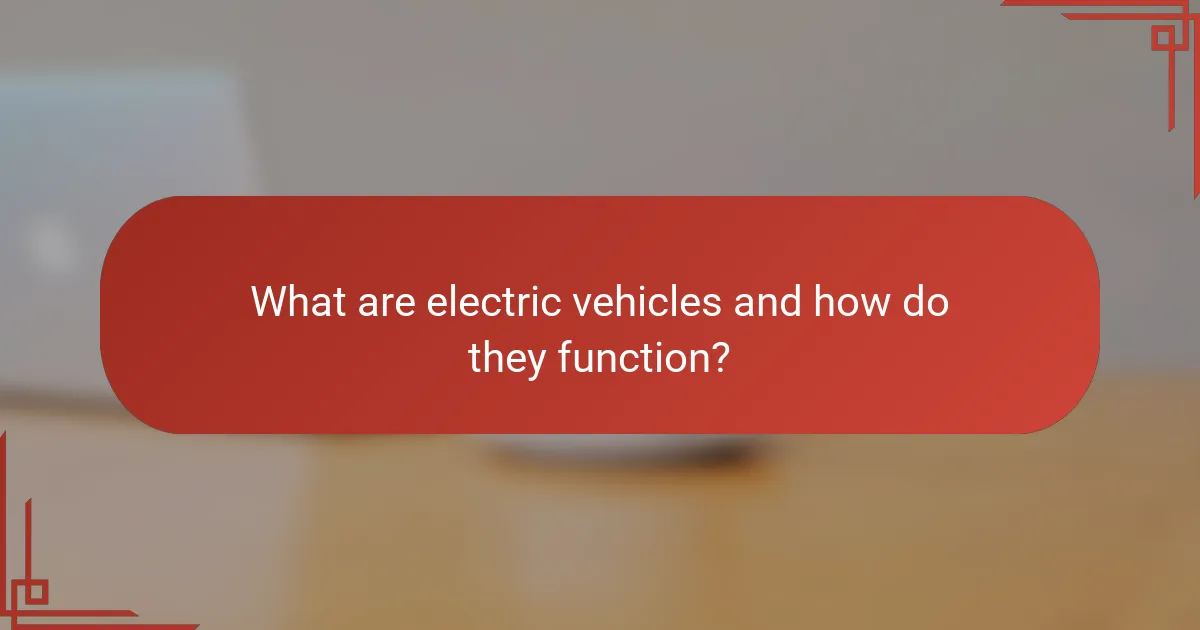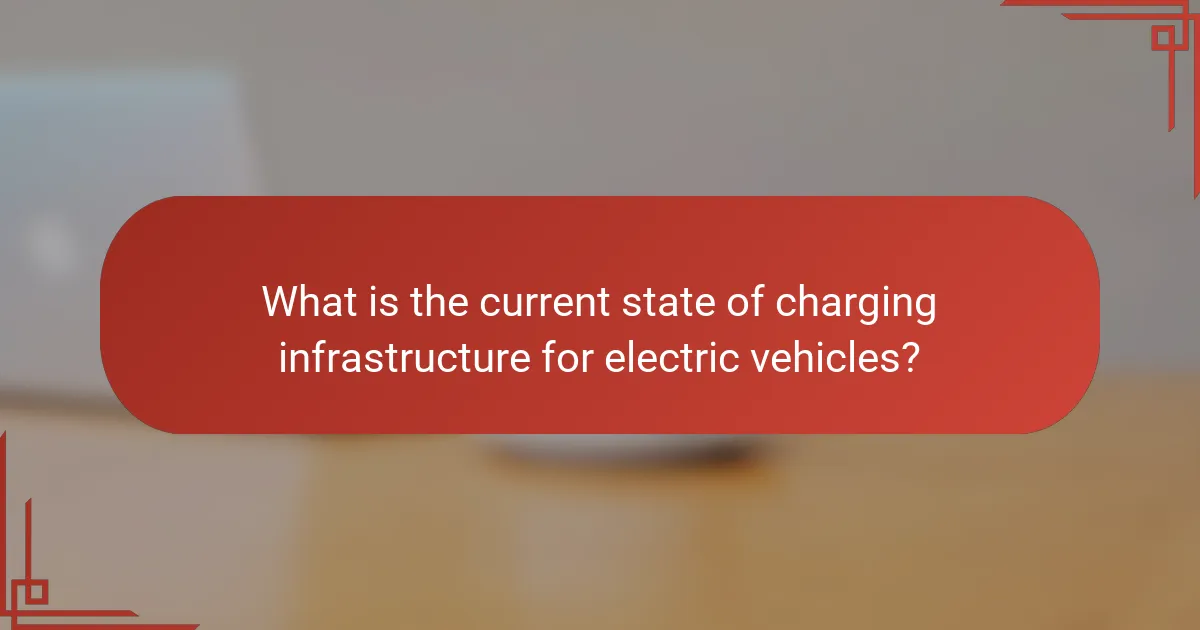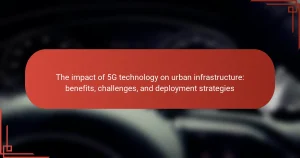Electric vehicles (EVs) are automobiles powered entirely or partially by electricity, utilizing electric motors and rechargeable batteries. This article explores the environmental benefits of EVs, highlighting their zero tailpipe emissions and significant potential to reduce greenhouse gas emissions compared to traditional vehicles. It also examines the rapid evolution of charging infrastructure, noting the increase in public charging stations and investments by automakers. Additionally, market trends reveal substantial growth in EV sales, advancements in battery technology, and government initiatives aimed at promoting electrification and achieving net-zero emissions by 2050.

What are electric vehicles and how do they function?
Electric vehicles (EVs) are automobiles that are powered entirely or partially by electricity. They utilize electric motors instead of internal combustion engines. EVs draw power from batteries that store electrical energy. These batteries can be recharged by plugging them into an electric power source.
The primary function of electric vehicles is to convert electrical energy into mechanical energy to drive the wheels. This process is more efficient than traditional fuel combustion. EVs produce zero tailpipe emissions, contributing to reduced air pollution.
According to the U.S. Department of Energy, electric vehicles can reduce greenhouse gas emissions significantly compared to conventional vehicles. In 2020, EVs accounted for about 2% of total U.S. vehicle sales, reflecting a growing market trend.
What are the different types of electric vehicles?
The different types of electric vehicles include Battery Electric Vehicles (BEVs), Plug-in Hybrid Electric Vehicles (PHEVs), and Fuel Cell Electric Vehicles (FCEVs). BEVs operate solely on electric power and have no internal combustion engine. They are charged through an external power source. PHEVs combine a conventional internal combustion engine with an electric propulsion system. They can operate on electric power alone for a limited range before switching to gasoline. FCEVs use hydrogen fuel cells to generate electricity, emitting only water vapor as a byproduct. According to the International Energy Agency, the global stock of electric cars surpassed 10 million in 2020, highlighting the growing adoption of these vehicle types.
How do battery electric vehicles differ from hybrid electric vehicles?
Battery electric vehicles (BEVs) differ from hybrid electric vehicles (HEVs) primarily in their power sources. BEVs are powered solely by electric batteries and produce zero tailpipe emissions. In contrast, HEVs combine an internal combustion engine with an electric motor, relying on both gasoline and electricity for propulsion.
BEVs require charging from external sources, while HEVs can operate on gasoline when the battery is depleted. The driving range of BEVs is generally limited by battery capacity, while HEVs can extend their range using gasoline.
According to the U.S. Department of Energy, BEVs typically have lower operating costs due to fewer moving parts and no fuel costs. In contrast, HEVs offer a blend of electric efficiency and traditional fuel usage.
What role do plug-in hybrid electric vehicles play in the market?
Plug-in hybrid electric vehicles (PHEVs) serve as a transitional option in the automotive market. They combine internal combustion engines with electric propulsion. This dual system allows for reduced emissions compared to traditional vehicles. PHEVs provide flexibility with extended driving ranges. They can operate on electric power for short trips, reducing fuel consumption. According to the International Energy Agency, PHEVs accounted for 6% of global electric vehicle sales in 2021. Their popularity is growing due to increasing environmental awareness. PHEVs also contribute to the development of charging infrastructure. This supports the broader adoption of fully electric vehicles in the future.
How do electric vehicles contribute to environmental sustainability?
Electric vehicles (EVs) significantly contribute to environmental sustainability by reducing greenhouse gas emissions. Traditional vehicles emit carbon dioxide and other pollutants, whereas EVs produce zero tailpipe emissions. According to the U.S. Department of Energy, EVs can reduce emissions by 50% compared to gasoline-powered cars. Additionally, EVs promote cleaner air quality in urban areas. They also encourage the use of renewable energy sources when charged with clean electricity. The International Energy Agency reports that widespread EV adoption could lead to a reduction of up to 1.5 gigatons of CO2 emissions by 2030. Furthermore, EVs help decrease dependence on fossil fuels, promoting energy security and sustainability.
What are the key environmental benefits of electric vehicles?
Electric vehicles (EVs) significantly reduce greenhouse gas emissions. They produce zero tailpipe emissions, unlike traditional gasoline vehicles. This leads to improved air quality in urban areas. EVs also contribute to lower noise pollution, promoting quieter environments. Additionally, using renewable energy sources to charge EVs further decreases their carbon footprint. Research shows that EVs can reduce carbon dioxide emissions by up to 70% compared to conventional vehicles. Overall, the transition to electric vehicles supports climate change mitigation efforts.
How do electric vehicles reduce greenhouse gas emissions?
Electric vehicles reduce greenhouse gas emissions by eliminating tailpipe emissions. Unlike gasoline or diesel vehicles, electric vehicles (EVs) operate on electricity, which can be generated from renewable sources. When charged with renewable energy, EVs contribute significantly less to greenhouse gas emissions compared to traditional vehicles. According to the U.S. Department of Energy, EVs produce no direct emissions during operation. Furthermore, the lifecycle emissions of EVs are lower, even when accounting for manufacturing and electricity generation. This reduction is crucial in combating climate change and improving air quality.

What is the current state of charging infrastructure for electric vehicles?
The current state of charging infrastructure for electric vehicles is rapidly evolving. As of 2023, there are over 150,000 public charging stations in the United States. This includes both Level 2 chargers and DC fast chargers. The growth rate of charging stations has increased by approximately 30% annually. Major automakers are investing heavily in expanding charging networks. For example, Tesla has built over 30,000 Superchargers globally. Government initiatives are also supporting infrastructure development through funding and incentives. Many regions are implementing plans to increase the number of charging points in urban and rural areas. This expansion aims to alleviate range anxiety among potential electric vehicle buyers.
How does charging infrastructure impact electric vehicle adoption?
Charging infrastructure significantly impacts electric vehicle adoption by providing essential access to charging stations. The availability of charging points reduces range anxiety among potential electric vehicle buyers. Studies show that regions with extensive charging networks see higher electric vehicle sales. For instance, California, with over 70,000 charging stations, leads the U.S. in electric vehicle ownership. Conversely, areas with limited charging options experience slower adoption rates. A report by the International Energy Agency indicates that robust charging infrastructure can increase electric vehicle market share by up to 30%. Therefore, the presence and accessibility of charging infrastructure are critical for encouraging electric vehicle usage.
What are the different types of charging stations available?
The different types of charging stations available are Level 1, Level 2, and DC Fast Charging stations. Level 1 charging stations use a standard 120-volt outlet. They are typically used for home charging and provide about 4-5 miles of range per hour. Level 2 charging stations operate on a 240-volt supply. They are commonly found in public charging locations and can deliver 10-60 miles of range per hour. DC Fast Charging stations use direct current to charge vehicles rapidly. They can provide 60-100 miles of range in just 20-30 minutes. Each type of charging station serves different needs based on charging speed and location.
How does charging speed vary among different types of chargers?
Charging speed varies significantly among different types of chargers. Level 1 chargers typically provide 1.4 kW, taking 8 to 12 hours for a full charge. Level 2 chargers offer 3.3 to 19.2 kW, allowing a full charge in 4 to 8 hours. DC fast chargers deliver 50 kW or more, enabling an 80% charge in 30 minutes or less. The charging speed is influenced by the charger’s power output and the vehicle’s acceptance rate. For instance, a vehicle designed for fast charging will benefit more from a DC fast charger than a Level 2 charger. This variance in charging speed is crucial for users to consider based on their driving habits and charging availability.
What challenges exist in developing charging infrastructure?
Developing charging infrastructure faces several challenges. The high cost of installation is a significant barrier. Charging stations require substantial upfront investment. Limited availability of suitable locations further complicates development. Urban areas often have space constraints. Rural regions may lack sufficient demand to justify installation. Standardization of charging technology is also an issue. Different manufacturers use varying plug types and charging speeds. This creates confusion and limits interoperability. Regulatory hurdles can delay deployment. Local governments may have complex permitting processes. Additionally, the electric grid may require upgrades to support increased demand. These challenges collectively hinder the rapid expansion of charging infrastructure.
What are the limitations of current charging technologies?
Current charging technologies face several limitations. One major limitation is the slow charging speed. Most standard chargers take several hours to fully charge an electric vehicle. This can be inconvenient for users who require quick turnaround times. Another limitation is the lack of universal compatibility. Different manufacturers use varying connectors and charging standards. This creates confusion and accessibility issues for consumers.
Additionally, charging infrastructure is often insufficient in many regions. Many areas lack enough charging stations to meet demand. This can lead to “range anxiety,” where users fear running out of charge. Furthermore, current technologies may not efficiently manage energy distribution. This can result in longer wait times during peak usage. Lastly, battery degradation over time affects charging efficiency. This can reduce the overall lifespan of the vehicle’s battery.
How can governments and private sectors collaborate to enhance infrastructure?
Governments and private sectors can collaborate to enhance infrastructure by developing public-private partnerships. These partnerships can pool resources and expertise to improve charging infrastructure for electric vehicles. For example, governments can provide funding or tax incentives, while private companies can invest in technology and installation. Jointly planning infrastructure projects ensures alignment with public needs and market demands. According to a report by the International Energy Agency, such collaborations have led to a 20% increase in charging station deployment in urban areas. This synergy fosters innovation and accelerates the transition to sustainable transportation.

What are the latest market trends in the electric vehicle industry?
The latest market trends in the electric vehicle industry include a significant increase in sales and investment. Global electric vehicle sales reached 6.6 million units in 2021, a 108% increase from 2020. Major automakers are committing to electrification, with over $500 billion planned for EV development by 2025. Battery technology advancements are reducing costs, making EVs more affordable. The average price of electric vehicles is projected to drop below $30,000 by 2025. Additionally, charging infrastructure is expanding rapidly, with over 100,000 public charging stations in the U.S. alone. Government incentives and regulations are also driving demand, with many countries aiming for net-zero emissions by 2050. These trends indicate a robust growth trajectory for the electric vehicle market.
How are consumer preferences shifting towards electric vehicles?
Consumer preferences are increasingly shifting towards electric vehicles (EVs) due to growing environmental concerns and advancements in technology. Many consumers prioritize sustainability and seek to reduce their carbon footprint. A 2022 survey by Deloitte found that 69% of consumers are more likely to buy an EV to support environmental sustainability. Additionally, improvements in battery technology have increased the driving range of EVs, making them more appealing. The availability of charging infrastructure has expanded, alleviating concerns about range anxiety. According to the International Energy Agency, global EV sales reached 6.6 million in 2021, a 108% increase from the previous year. This trend indicates a strong consumer shift towards electric vehicles as a viable alternative.
What factors influence consumer decisions when purchasing electric vehicles?
Consumer decisions when purchasing electric vehicles are influenced by factors such as price, range, charging infrastructure, and environmental impact. Price remains a significant determinant as consumers often compare electric vehicle costs to traditional vehicles. Range anxiety affects consumer confidence, with many preferring models that offer longer driving distances on a single charge. The availability of charging stations plays a crucial role; consumers are more likely to purchase if they perceive adequate infrastructure. Environmental concerns also impact decisions, as many consumers are motivated by the desire to reduce their carbon footprint. According to a 2021 survey by the International Council on Clean Transportation, 60% of potential buyers prioritize environmental benefits when selecting an electric vehicle.
How do electric vehicle incentives affect market trends?
Electric vehicle incentives significantly boost market trends by increasing consumer adoption. These incentives include tax credits, rebates, and grants that lower purchase costs. As a result, sales of electric vehicles have surged. For instance, in the United States, the federal tax credit can provide up to $7,500 off the purchase price. Studies indicate that states with robust incentives see a higher percentage of electric vehicle registrations. According to the International Council on Clean Transportation, California’s incentives contributed to over 50% of the nation’s electric vehicle sales in 2020. Furthermore, incentives can stimulate automaker investments in electric vehicle technology and infrastructure. This leads to more models and improved charging networks, further driving consumer interest. Overall, electric vehicle incentives create a positive feedback loop that enhances market growth and sustainability.
What is the future outlook for electric vehicle sales and production?
The future outlook for electric vehicle sales and production is highly optimistic. Global sales are projected to reach 26 million units by 2030. This represents a significant increase from approximately 10 million units sold in 2022. Major automakers are investing heavily in electric vehicle technology. For example, companies like Tesla and Ford are expanding their production capacities. Additionally, government policies are increasingly supporting electric vehicle adoption. Incentives and regulations are promoting cleaner transportation options. The demand for electric vehicles is driven by consumer preferences for sustainability. Furthermore, advancements in battery technology are improving vehicle range and reducing costs. Overall, electric vehicle sales and production are expected to grow substantially in the coming years.
How are manufacturers adapting to rising demand for electric vehicles?
Manufacturers are increasing production capacity to meet the rising demand for electric vehicles (EVs). They are investing heavily in new manufacturing plants and upgrading existing facilities. For instance, major automakers like Ford and General Motors have announced multi-billion dollar investments in EV production. Additionally, manufacturers are expanding their electric vehicle lineups with new models. This includes both passenger cars and commercial vehicles. Furthermore, they are collaborating with battery suppliers to secure necessary components. This partnership ensures a stable supply chain for battery production. According to a report by BloombergNEF, global EV sales are expected to reach 10 million units by 2025. This statistic highlights the urgency for manufacturers to adapt quickly to market trends.
What role does technology play in shaping the future of electric vehicles?
Technology is crucial in shaping the future of electric vehicles (EVs). It enhances battery efficiency and reduces charging times. Innovations in battery technology, like solid-state batteries, promise greater energy density and safety. Advanced software improves vehicle performance and user experience. Connectivity features enable over-the-air updates and smart grid integration. Autonomous driving technology is also evolving, influencing vehicle design and functionality. According to the International Energy Agency, EV sales increased by 40% in 2020, highlighting technology’s impact on market growth. These advancements drive consumer adoption and influence infrastructure development.
What practical tips can consumers consider when choosing an electric vehicle?
Consumers should consider several practical tips when choosing an electric vehicle. First, evaluate the vehicle’s range on a single charge. Many electric vehicles offer ranges between 150 to 370 miles. Next, assess the availability of charging infrastructure in your area. Research local charging stations and their types, such as Level 2 and DC fast chargers. Consider the total cost of ownership, which includes maintenance, insurance, and potential tax incentives. Look into the vehicle’s battery warranty and lifespan, as many manufacturers provide warranties for eight years or 100,000 miles. Test drive multiple models to find the best fit for comfort and performance. Finally, read reviews and reliability ratings from trusted sources to make an informed decision.
Electric vehicles (EVs) are automobiles powered entirely or partially by electricity, utilizing electric motors and batteries to drive wheels while producing zero tailpipe emissions. The article explores the various types of EVs, including Battery Electric Vehicles (BEVs), Plug-in Hybrid Electric Vehicles (PHEVs), and Fuel Cell Electric Vehicles (FCEVs), highlighting their environmental benefits and contributions to sustainability. Additionally, it discusses the current state of charging infrastructure, the challenges in its development, and market trends influencing consumer preferences and manufacturer adaptations in response to rising demand for electric vehicles.


